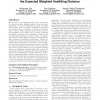492 search results - page 37 / 99 » Ranking Entities Using Web Search Query Logs |
WWW
2007
ACM
14 years 8 months ago
2007
ACM
Determining the user intent of Web searches is a difficult problem due to the sparse data available concerning the searcher. In this paper, we examine a method to determine the us...
WWW
2008
ACM
14 years 8 months ago
2008
ACM
Learning to rank is a new statistical learning technology on creating a ranking model for sorting objects. The technology has been successfully applied to web search, and is becom...
WWW
2010
ACM
14 years 2 months ago
2010
ACM
We introduce a new dissimilarity function for ranked lists, the expected weighted Hoeffding distance, that has several advantages over current dissimilarity measures for ranked s...
SIGIR
2008
ACM
13 years 7 months ago
2008
ACM
Personalized search is a promising way to better serve different users' information needs. Search history is one of the major information sources for search personalization. ...
SIGMOD
2006
ACM
14 years 7 months ago
2006
ACM
The original PageRank algorithm for improving the ranking of search-query results computes a single vector, using the link structure of the Web, to capture the relative "impor...

